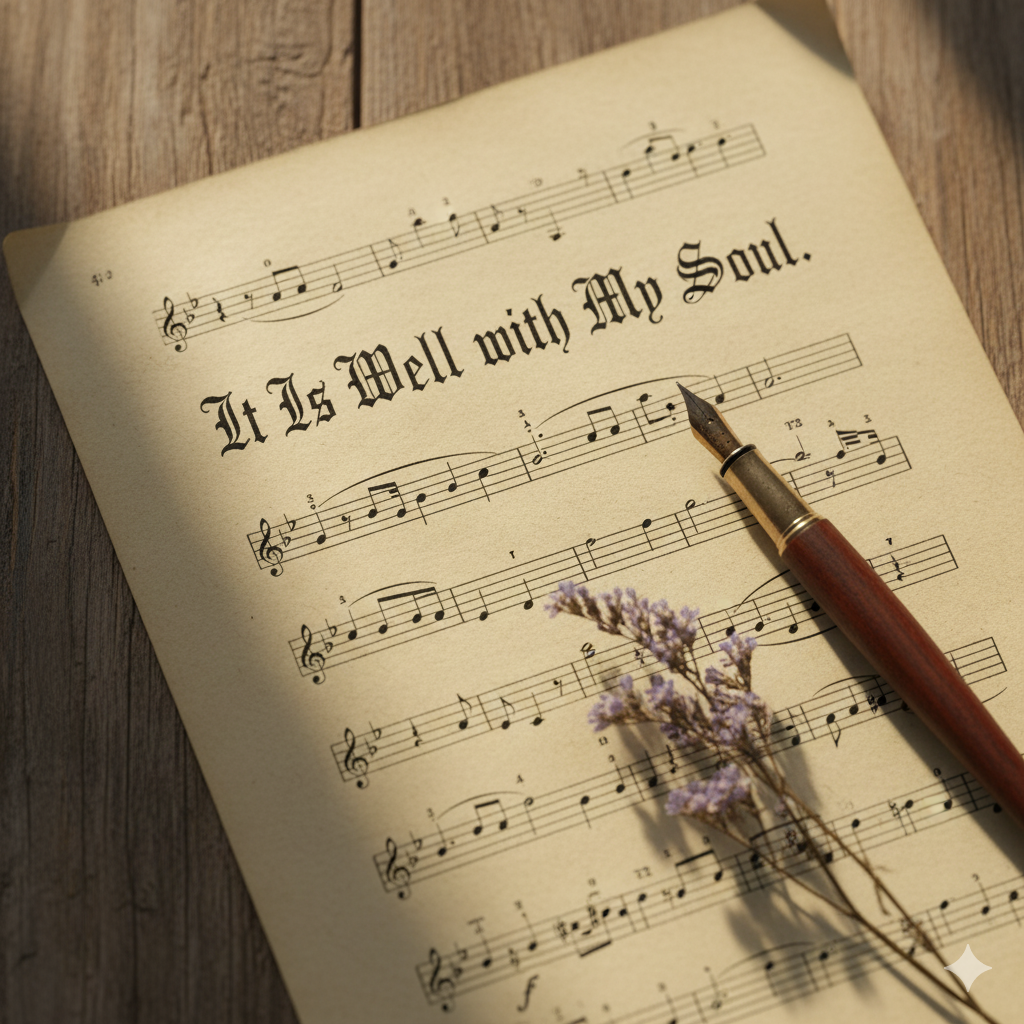When Peace Like a River Lyrics: Complete Hymn, Meaning & History
In moments of trial, turmoil, or quiet contemplation, many of us turn to music for solace. Certain hymns possess a timeless quality, their melodies and words offering a sanctuary for the soul. Among the most cherished of these is the piece that begins, “When peace, like a river, attendeth my way.” People often search for the when peace like a river lyrics not just to sing along, but to reconnect with a profound message of hope and resilience that has comforted generations. This hymn serves as a powerful tool for spiritual reflection, a reminder that peace can be found even when life’s seas are at their most turbulent. Understanding the lyrics of peace like a river is to understand a story of unshakable faith in the face of unimaginable loss, making its message of healing and tranquility all the more poignant.
Full Lyrics of “When Peace Like a River”
Here are the lyrics of peace like a river as they were originally penned by Horatio Spafford. While the opening line is what most people search for, the full hymn, properly titled “It Is Well with My Soul,” unfolds a deeper journey of faith, sorrow, and ultimate redemption. The stanzas are presented below for reflection and singing.
Stanza 1:
When peace, like a river, attendeth my way,
When sorrows like sea billows roll;
Whatever my lot, Thou hast taught me to say,
It is well, it is well with my soul.
Refrain:
It is well with my soul,
It is well, it is well with my soul.
Stanza 2:
Though Satan should buffet, though trials should come,
Let this blest assurance control,
That Christ hath regarded my helpless estate,
And hath shed His own blood for my soul.
Refrain:
It is well with my soul,
It is well, it is well with my soul.
Stanza 3:
My sin, oh, the bliss of this glorious thought!
My sin, not in part but the whole,
Is nailed to the cross, and I bear it no more,
Praise the Lord, praise the Lord, O my soul!
Refrain:
It is well with my soul,
It is well, it is well with my soul.
Stanza 4:
And Lord, haste the day when my faith shall be sight,
The clouds be rolled back as a scroll;
The trump shall resound, and the Lord shall descend,
Even so, it is well with my soul.
Refrain:
It is well with my soul,
It is well, it is well with my soul.
These are the original peace like a river song lyrics still sung today in churches and homes around the world, a testament to their enduring power.
The Meaning Behind the Hymn
To truly grasp the hymn’s depth, one must look beyond the surface of its poetic words. The peace like a river song lyrics meaning is a profound declaration of faith and acceptance, rooted in the belief that spiritual well-being can transcend earthly circumstances. It’s not about the absence of pain, but the presence of a deeper, divine peace that sustains through it.
The central metaphor, “peace like a river,” is a powerful image found throughout religious and poetic writing. Unlike the violent, unpredictable nature of the sea—which Spafford contrasts with “sorrows like sea billows roll”—a river suggests a steady, constant, and life-giving flow. It moves forward, carving its path through the landscape, nourishing everything it touches. This metaphor suggests a peace that is not stagnant or fleeting but is an active, persistent current flowing from a divine source, capable of weathering any storm. It is a peace that “attendeth my way,” meaning it is a constant companion on life’s journey.

For many who use this hymn for reflection, it becomes a mantra for overcoming adversity. The lyrics acknowledge life’s darkest moments—”sorrows like sea billows roll,” “Satan should buffet,” “trials should come”—rather than pretending they don’t exist. The power lies in the response: “Whatever my lot, Thou hast taught me to say, It is well, it is well with my soul.” This is a radical act of faith. It re-frames suffering not as a sign of abandonment, but as an experience through which a steadfast spiritual core can be maintained.
From the perspective of BeMyHealer.com, the hymn’s themes tie directly into modern concepts of stress relief, healing, and meditation. The act of singing or reciting these words can be a meditative practice. It shifts focus from external stressors to an internal state of being, affirming a sense of peace that is independent of circumstances. The hymn teaches a form of spiritual resilience, a belief that one’s soul can remain whole and at peace even when the heart is breaking. This message is a powerful antidote to the anxiety and uncertainty of modern life, offering a timeless method for finding an anchor in the storm.
Historical Background of “When Peace Like a River”
The story behind this beloved hymn is one of heartbreaking tragedy and unwavering faith, which gives the lyrics their profound emotional weight. The hymn when peace like a river lyrics were written by Horatio G. Spafford, a successful lawyer and real estate investor who lived in Chicago in the late 19th century. Spafford was a devout Christian and a close friend of the famous evangelist Dwight L. Moody.
Spafford’s life was marked by a series of devastating losses. In 1870, his young son died of scarlet fever. A year later, in 1871, the Great Chicago Fire wiped out most of his vast real estate investments, leaving him financially ruined. Despite these immense setbacks, his faith remained.

Seeking a period of rest and recovery for his family, and wanting to assist with one of Moody’s evangelical campaigns in England, Spafford planned a trip to Europe in November 1873. He sent his wife, Anna, and their four daughters—Annie, Maggie, Bessie, and Tanetta—ahead on the ocean liner SS Ville du Havre, planning to follow a few days later after business matters were resolved.
On November 22, 1873, the Ville du Havre was struck by an English iron sailing ship, the Loch Earn, and sank in just 12 minutes. Two hundred and twenty-six people perished, including all four of Spafford’s daughters. His wife, Anna, miraculously survived. Upon reaching Cardiff, Wales, she sent her husband a now-famous telegram: “Saved alone. What shall I do…”
Horatio Spafford immediately booked passage on the next available ship to join his grieving wife. As his vessel passed over the very spot in the Atlantic Ocean where his daughters had drowned, the captain called him to the deck to note the location. It was in this moment of profound grief and anguish, staring into the watery grave of his children, that Spafford penned the words that would become “It Is Well with My Soul.” The opening lines, “When peace, like a river, attendeth my way, When sorrows like sea billows roll,” directly reference his personal experience of grappling with an inner peace amidst overwhelming sorrow.
The hymn was first published in 1876, with music composed by the celebrated gospel songwriter Philip P. Bliss. It was quickly adopted into hymnals and became a cornerstone of church worship, its popularity growing as people learned of the incredible story behind its creation. The evolution of its popularity is tied to its universal message: that faith can provide a peace that surpasses all understanding, a message born from one man’s unimaginable pain.
Why This Hymn Brings Comfort and Peace
The enduring appeal of “When Peace Like a River” lies in its unique ability to soothe the human spirit, a quality that can be understood from both a spiritual and psychological perspective. Its structure, melody, and message work in concert to create a powerful experience of comfort and tranquility.
From a psychological angle, the very act of singing has been shown to have therapeutic benefits. The deep, controlled breathing required for singing can calm the nervous system, similar to techniques used in meditation and mindfulness. The rhythm and melody of a hymn provide structure and predictability, which can be incredibly grounding during times of emotional chaos or anxiety. The repetitive nature of the refrain, “It is well, it is well with my soul,” acts as an affirmation or mantra. Repeating this phrase helps to internalize the message, overriding anxious or sorrowful thoughts and reinforcing a sense of calm and control. This connection between music, rhythm, and stress management is a key reason why this hymn, and others like it, have remained so vital for so long.
Spiritually, the hymn offers a framework for processing grief and hardship. It validates feelings of sorrow (“sorrows like sea billows roll”) while simultaneously offering a profound source of hope. It doesn’t promise a life free of pain; instead, it provides a tool to navigate that pain. By anchoring one’s well-being in the soul’s connection to the divine rather than in external circumstances, the hymn empowers the listener to find peace in the present moment, regardless of what that moment holds. It serves as a gentle but powerful reminder that our ultimate well-being is not defined by our trials. For those seeking spiritual solace, this hymn is a direct path to feeling held and understood. For a deeper dive into this type of spiritual practice, consider exploring a Prayer for Peace of Mind.
Popular Covers and Performances
Over the nearly 150 years since its creation, “When Peace Like a River” has been interpreted by countless artists, choirs, and congregations, each bringing their own unique emotional and musical styling to the timeless lyrics. Its message has resonated across genres, from traditional choral arrangements to contemporary Christian music, gospel, and even folk renditions.
Some of the best-known recordings come from legendary gospel singers who have infused the hymn with deep, soulful expression, emphasizing the themes of trial and redemption. Modern worship groups have also adopted the hymn, often setting it to new, more contemporary melodies or adding powerful instrumental bridges to create an anthemic experience for large congregations. These versions highlight the communal power of the song, transforming it from a personal reflection into a collective declaration of faith.
Choirs around the world continue to perform classic, four-part harmony arrangements, preserving the stately and reverent feel of the original composition by Philip Bliss. These performances often emphasize the hymn’s theological depth and its place within the rich history of Christian music. Exploring these different interpretations can offer new perspectives on the lyrics; a quiet, acoustic version might highlight the hymn’s meditative qualities, while a full-throated gospel performance can underscore its triumphant message of hope.
Sheet Music and Audio Versions
For those who wish to learn, play, or simply listen to this hymn, there are abundant resources available. Because the original composition by Philip P. Bliss (1876) is in the public domain, the when peace like a river lyrics sheet music is widely and freely available online. Websites dedicated to church music, as well as large digital archives, offer downloadable PDFs for piano, organ, and vocal arrangements. This accessibility allows musicians, church choirs, and individuals at home to engage with the music directly.
Audio versions are just as accessible. The hymn is a staple on streaming services like Spotify and Apple Music, featured on countless albums of classic hymns, gospel collections, and meditative music compilations. Searching for “It Is Well with My Soul” will yield hundreds of different recordings, from the classic to the contemporary.
For a curated listening experience focused on tranquility and reflection, consider adding a favorite version of this hymn to a personal playlist. Its calming melody and reassuring lyrics make it a perfect fit for moments of quiet devotion, meditation, or stress relief.
How to Use “When Peace Like a River” in Daily Life
For Meditation and Prayer
The lyrics of peace like a river are beautifully suited for meditation and prayer. Begin by finding a quiet space and reading the stanzas slowly. Focus on a single line that resonates with you, such as “Whatever my lot, Thou hast taught me to say, It is well.” Sit with the phrase, breathing deeply and allowing its meaning to sink in. You can use the refrain as a mantra, repeating “It is well with my soul” to help center your thoughts and calm your mind. This practice can be especially powerful during times of high stress or uncertainty, providing a spiritual anchor to hold onto.
For Stress Relief and Healing
The calming effect of this hymn is undeniable. When you feel overwhelmed by anxiety or sorrow, try listening to a gentle, instrumental version of the song. Let the melody wash over you, focusing on the feeling of “peace like a river.” This musical therapy can lower your heart rate and ease tension in your body. Singing the hymn aloud can also be a cathartic release, giving voice to your struggles while simultaneously affirming your hope for peace. This practice aligns perfectly with other holistic approaches to well-being.
In Worship and Community Gatherings
Hymns like this one create a powerful sense of unity and shared experience when sung in a group. In a church service, family gathering, or community choir, singing “When Peace Like a River” together connects individuals through a common message of faith and resilience. It reminds participants that they are not alone in their struggles and that peace is a collective as well as an individual pursuit. The shared act of singing builds bonds and fosters a supportive environment where healing and peace can flourish.
Related Hymns and Alternatives for Peace
The themes of peace, trust, and surrender found in “When Peace Like a River” are echoed in many other beloved hymns. If this song resonates with you, you may also find comfort in these alternatives:
- Be Still, My Soul: This hymn, set to the melody of Sibelius’s Finlandia, is a powerful call to quiet the soul and trust in God’s plan, even through grief and fear.
- Amazing Grace: Perhaps the most famous hymn of all, it tells a story of redemption and finding peace through grace, a perfect companion to the message of “It Is Well.”
- Great Is Thy Faithfulness: A hymn that celebrates the constancy and reliability of God’s presence, offering a sense of security and unwavering peace.
Exploring these themes beyond music can also be enriching. Understanding the symbolism of peace, such as through crystals or learning about colors, can deepen your practice of cultivating tranquility. Ultimately, the goal is to find sources of comfort that speak to you, and a spiritual practice like a prayer for peace of mind can be a cornerstone of that journey.
FAQs on “When Peace Like a River Lyrics”
Is “When Peace Like a River” the same as “It Is Well with My Soul”?
Yes. “When Peace Like a River” is the first line and popular title for the hymn, but its official title is “It Is Well with My Soul.” The two names are used interchangeably.
Who wrote the hymn?
The lyrics were written by Horatio G. Spafford, a Chicago lawyer, in 1873 after his four daughters died in a shipwreck. The music was composed by Philip P. Bliss.
Why is it still sung today?
The hymn remains popular because of its powerful and timeless message of finding peace and maintaining faith through immense suffering. Its incredible backstory and beautiful melody have allowed it to resonate with people across generations who are facing their own trials.
Where can I find sheet music and recordings?
Because the hymn is in the public domain, sheet music is widely available for free on websites dedicated to hymnody and music archives. Countless recordings by various artists can be found on streaming platforms like Spotify, Apple Music, and YouTube.
Final Reflection
The when peace like a river lyrics offer more than just a song; they present a profound spiritual lesson in resilience. Born from a moment of unimaginable pain, the hymn has transformed into a universal anthem of hope. It teaches that peace is not the absence of storms but the presence of an unwavering anchor within the soul. When Peace Like a River continues to flow through the hearts of millions, a gentle yet powerful current that inspires, comforts, and heals.
If you found comfort in this hymn, explore more guides on stress relief and peace at BeMyHealer.com.



